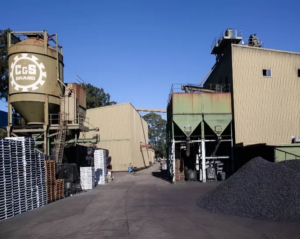Activated Carbon
Granular & Powdered Forms- High internal surface area
- Rapid diffusion kinetics
- Greater loading capacity
- Customisable particle sizing
- Manufactured by an ISO9001 accredited Quality system
Media filtration is a crucial process in water treatment, ensuring the removal of suspended solids, pathogens, and other contaminants. To achieve optimal performance, it is essential to choose the right filter media, maintain its quality, and rebuild filters when necessary. In this blog, we will explore the best practices for media selection and filter rebuilding, drawing insights from our experience and products available at James Cumming & Sons.

Filter media plays a pivotal role in the efficiency of water treatment systems. Its physical properties, including size, density, and composition, significantly affect filtration rates and water quality. Here’s what to consider when selecting the best filter media.
When choosing filter media, two parameters are particularly important: Effective Size (ES) and Uniformity Coefficient (UC). The ES determines the pore size in the media bed, influencing the penetration of suspended particles. A higher ES typically allows for faster filtration rates but may reduce particle capture efficiency. Meanwhile, the UC indicates the uniformity of media grain size. A lower UC (closer to 1.0) ensures a more uniform bed, promoting even flow distribution and minimising clogging.
At James Cumming & Sons, our range of Australian Filter Coal offers a variety of grain sizes tailored to meet different filtration needs. For example, our bituminous coal has an optimal ES and a UC designed for both single and dual-media filters, providing effective particle capture while maintaining high filtration rates. This makes our products suitable for various water treatment applications, ensuring reliable filtration performance.

1. Filter Coal
Our bituminous filter coal is known for its hardness, high specific gravity, and low friability. These properties ensure that the media withstands backwashing forces, extending its life and maintaining filtration efficiency. With the correct bed depth, our filter coal can remove a wide range of particle sizes, making it ideal for municipal and industrial water treatment.
2. Granular Activated Carbon (GAC)
GAC is another excellent option for water treatment, especially for removing organic contaminants and improving taste and odour. At James Cumming & Sons, our GAC products have a large surface area, promoting effective adsorption of organic compounds, chlorine, and other chemicals.
The lifespan of filter media depends on various factors, including water quality, backwashing efficiency, and the filter’s operational conditions. Over time, media can become clogged with particulate matter, resulting in increased head loss and reduced filtration capacity. To maintain optimal filtration performance, it is essential to monitor media conditions regularly and replace it as needed.
Rebuilding a filter is sometimes necessary when performance declines or during regular maintenance cycles. A well-executed rebuild can restore filter capacity, enhance water quality, and extend the life of the filter system. Here’s a step-by-step guide to effectively rebuilding filters.
1. Getting Started
Before starting the rebuilding process, it is crucial to understand the current condition of the filter. Begin by inspecting the media bed, checking for signs of mudball formation, channelling, and compaction. Any significant media loss or deterioration indicates that a rebuild is necessary. Proper planning, including sourcing high-quality media from trusted suppliers like James Cumming & Sons, is key to a successful filter rebuild.
2. Dismantling the Filter
The first step in the rebuild is to carefully remove the old media. It is vital to ensure that no traces of the old sand, coal, or GAC remain in the filter bed, as residues can affect the performance of the new media. Use a vacuum or a pump system to remove the old media and dispose of it according to environmental regulations.
3. Nozzle Inspection and Replacement
Nozzles play a critical role in even distribution of water during filtration and backwashing. During the rebuild, inspect all filter nozzles for signs of wear, blockage, or damage. Replace any defective nozzles to ensure uniform flow and prevent uneven filtration, which can lead to suboptimal water quality. High-quality nozzles are available through trusted suppliers, ensuring compatibility and durability for your filter systems.
4. Rebuilding the Media Bed
When rebuilding the filter, it is essential to layer the media correctly to achieve optimal filtration. For dual-media filters, start by placing a layer of support gravel, followed by sand and topped with filter coal. The correct media depth ensures adequate contact time for particle removal and prevents media loss during backwashing.
At James Cumming & Sons, our Industrial Filter Coal is specifically designed to provide excellent filtration in both mono- and dual-media filter setups. With precise sizing and high durability, our filter coal minimises head loss while maximising filtration efficiency.
5. Recommissioning the Filter
After placing the new media, it is time to recommission the filter. Slowly introduce water into the system to avoid disturbing the newly placed media. Backwash the filter gently to remove any fine particles or debris introduced during the rebuild. After backwashing, the filter is ready for operation. Regularly monitor the system to ensure it operates within design parameters, adjusting filtration rates and backwashing frequencies as necessary.

As experts in filtration solutions, James Cumming & Sons provides high-quality filter coal and granular activated carbon designed to enhance water treatment performance. Our products are manufactured to precise specifications, ensuring they meet the diverse needs of water treatment plants. By choosing our C&S Brand Australian Filter Coal, you are investing in a media that offers durability, effective particle removal, and a longer service life.
We have over 115 years of experience in pioneering Australian Coal for industry.
Our products meet exact customers specifications, and we deliver safely and promptly.
For Australian Coal, Activated Carbon or Support Filter Media for your next project, contact JC&S today on +61 2 9748 2309 or at [email protected]
for your Filter Coal, Activated Carbon and Carbon additive needs











James Cumming & Sons
319 Parramatta Road,
Auburn NSW 2144 Australia

© Copyright 2024 James Cummings & Sons Pty Ltd. Website by Brilliant Digital
The C&S Brand™ logo are trademarks of James Cumming & Sons Pty Ltd.
ABN 98 000 453 378